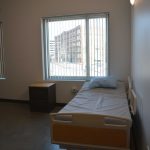By the numbers | Partner Organizations | Key Services | Capital Campaign | The Need | Timeline
Catholic Charities Opens Dorothy Day Place
On October 23, Catholic Charities of St. Paul and Minneapolis marked the completion of Dorothy Day Place, a two-building campus designed to prevent and end homelessness.
Information about the Dorothy Day Place, as well as downloadable images/renderings of Higher Ground Saint Paul, Richard M. Schulze Family Foundation Saint Paul Opportunity Center and Dorothy Day Residence are below. If you have any questions, please contact Therese Gales at 612-204-8343 or therese.gales@cctwincities.org
Downloads
⯆ Dorothy Day Place Factsheet
⯆ Dorothy Day Place: What key community leaders are saying
Photos
- View from the west of Higher Ground Saint Paul
- Higher Ground Saint Paul view from street
- Higher Ground Saint Paul view from the east
- Dorothy Day Place
- Street view of Saint Paul Opportunity Center
- Aerial view of Saint Paul Opportunity Center
- Higher Ground Saint Paul view from the west
- Higher Ground Saint Paul view from the street
- Higher Ground Saint Paul view from the street
- Higher Ground Saint Paul medical respite room
- Higher Ground Saint Paul medical respite room
- Typical room in Higher Ground Saint Paul
- Bunks at Higher Ground Saint Paul Shelter
- Hallway Higher Ground Saint Paul
- Computer lab
- Common kitchen at Dorothy Day Residence
- Dorothy Day Residence room
- Laundry facilities
- View of Saint Paul Opportunity Center from Higher Ground Saint Paul
- Technology center
By the numbers
All told, Dorothy Day Place will provide services each day to an estimated 1,000 people who have nowhere else to turn, and its impacts will be felt statewide. Over the past two years, it has served residents from 69 of Minnesota’s 87 counties. The campus offers:
- 726 people with a safe place to sleep each night in the emergency shelter and permanent housing areas.
- Emergency and transitional shelter with semi-private bunk beds for 356 men and women.
- Pay-for-Stay shelter for 54 guests who pay a nominal nightly fee that is deposited into a personal savings account. Residents can use that account to pay rent or a deposit on stable housing.
- Permanent supportive housing for 370 people; veterans receive preference for all housing at Dorothy Day Place.
- The 370 housing units include dedicated housing units for key populations, including veterans (15 units), youth and young adults age 18-24 (11 units), women struggling with severe alcohol and other substance use disorders (12 units) — and a medical respite wing where individuals experiencing homelessness recover after hospital stays (10 units).
Partner Organizations
Access to daytime services for an estimated 300 people each day. This on-site integration of services will remove barriers for clients, providing them access to services to prevent homelessness and increase stability, and it will significantly enhance the impact of these partner organizations. Partner organizations offering services at the Dorothy Day Place include:
- Ramsey County adult services, public health, social services, financial assistance services, workforce solutions, veterans services, child support and corrections
- Minnesota Community Care
- U.S. Department of Veterans Affairs (VA) Health Systems
- Minnesota Assistance Council for Veterans (MACV)
- People Incorporated
- RADIAS Health
- University of Minnesota
- Avivo
- Mile in My Shoes
- Open Access Connections
Key Services
Key services offered at Dorothy Day Place include:
- Physical, mental and chemical health care services, including dental care and podiatry
- Employment training programs and job search assistance
- Housing search and placement services
- Access to veterans’ benefits, SNAP, Medical Assistance and other supports
- Financial and legal support services
- Nutritious meals, showers, laundry and storage
- Wellness and community-building opportunities
- A medical respite unit, an innovative partnership with United Hospital (Allina Health), Regions Hospital (HealthPartners) and Saint Joseph’s Hospital (M Health Fairview) that provides rooms, nurse care coordination, medication assistance and behavioral health services to help up to 10 individuals experiencing homelessness recover after hospital stays.
The Private Capital Campaign: $40 Million Raised
In addition to $60 million contributed by the state of Minnesota, Ramsey County, the city of Saint Paul and other public sources, the Capital Campaign for Dorothy Day Place raised $40 million from private sources. More than 500 individuals and organizations contributed to the Dorothy Day Place private fundraising campaign.
The capital campaign was spearheaded by 16 prominent regional business and civic leaders, including co-chairs Doug Baker, Jr., chairman and CEO of Ecolab; Mary Brainerd, former president and CEO of HealthPartners; and Andy Cecere, president and CEO of U.S. Bank. The campaign launched in May 2015 with a $5 million lead challenge grant by Richard M. Schulze Family Foundation. Other contributions of $1 million or more include Target ($2 million), 3M; Julie and Doug Baker, Jr. Foundation; The Casale Family; Ecolab Foundation; Frey Foundation of Minnesota; Hardenbergh Foundation; Patrick and Patti McAdaragh; Pohlad Family Foundation; Premier Banks; and U.S. Bank Foundation
The Need
The completion of Dorothy Day Place comes at a critical time, as increasing rents, stagnant wages and a lack of affordable housing have contributed to a housing and homelessness crisis. While progress has been made in reducing veteran and family homelessness, the number of unsheltered homeless in the Twin Cities is increasing at a rate that is five times higher than the rest of the country and nearly doubled from 2015 to 2018. This contributed to an increasing number of people sheltering outside in cars, under bridges and in other places not meant for human habitation in both Minneapolis and Saint Paul. State projections indicate the number of unsheltered homeless will continue to increase dramatically in the coming year. On a single night in 2018, the U.S. Department of Housing and Urban Development estimated that there were 7,243 people without a home or shelter across the state of Minnesota, with 5,062 in the seven-county metro area.
Since the first phase of Dorothy Day Place opened in 2017, the model is already seeing success and is serving as a foundation for new ideas. Community partners have launched initiatives to provide permanent homes to the top users of shelter in Ramsey County and to address the growth of unsheltered homelessness in our community.
Timeline
-
1981
The Dorothy Day Center opens.
The Dorothy Day Center opened in Saint Paul as a drop-in center for meals. Over time, due to increasing homelessness, the center transitioned into an overnight shelter – something it was never designed or intended to do.
-
2011
Catholic Charities was forced to turn people away
For the first time in its history, Catholic Charities was forced to turn people away from the Dorothy Day Center, leading people to camp in the surrounding area.
-
2012
Mayor Chris Coleman convenes task force.
Saint Paul Mayor Chris Coleman convened a diverse task force of community leaders to assess the urgent situation of overcrowding at the Dorothy Day Center.
-
2013
The task force issued its recommendation.
The task force issued its recommendation for an innovative new vision to prevent and end homelessness. Dorothy Day Place evolved from this community-driven process.
-
2017
Higher Ground Saint Paul opens.
The first phase of the Dorothy Day Place project which includes a larger, more dignified emergency shelter and permanent housing units opens on January 12.
-
2019
Saint Paul Opportunity Center and Dorothy Day Residence opens.
Catholic Charities of St. Paul and Minneapolis marked the completion of Dorothy Day Place, a two-building campus designed to prevent and end homelessness.



















